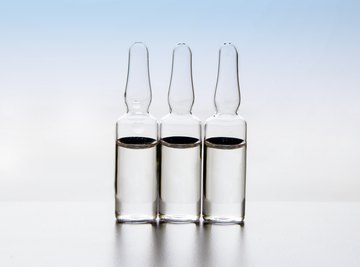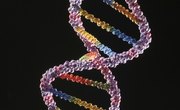
When a crime scene investigator or a doctor obtains a DNA sample, there often is not enough DNA available to properly analyze it. In order to simulate the body's own DNA replication process, scientists developed a process called PCR that can act like a Xerox machine and make copy after copy of a DNA sample. There are many components of a PCR reaction, and magnesium chloride is one of the most vital.
TL;DR (Too Long; Didn't Read)
Magnesium acts like a catalyst in the PCR reaction -- the enzyme required to replicate the DNA needs magnesium to function, and the PCR reaction won't work without magnesium in the mix.
Mimicking the Body
The polymerase chain reaction (PCR) was developed in order to mimic nature's own way of replicating DNA. DNA is a repeating sequence of nucleotides, and each nucleotide contains three parts. The backbone of DNA is a repeating sugar and phosphate unit, and each sugar has a nitrogenous base attached to it. There are four nitrogenous bases; guanine, cytosine, adenine and thymine. DNA consists of two sugar phosphate strands running parallel to one another with two nitrogenous bases joining in between every two sugars. When DNA replicates in the body, an enzyme called helicase breaks apart the bonds between the nitrogenous bases. A second enzyme, DNA polymerase, attaches new nucleotides in place of the old ones. Finally, a third enzyme called DNA ligase joins the new molecules back together.
PCR Reaction Components
A few changes have to be made in order to replicate DNA in a lab reaction. In place of helicase, a PCR reaction simply uses heat to break the bonds between the nitrogenous bases. Human DNA polymerase is not stable enough to withstand these temperatures. A similar molecule called Taq polymerase, or thermostable polymerase, is used in its stead, because it can withstand the heat requirements of PCR. Additionally, a PCR reaction requires free nucleotides, a buffer, and magnesium.
The Role of Magnesium Chloride
Magnesium chloride is the preferred method of adding magnesium to a PCR experiment. Thermostable polymerase requires the presence of magnesium to act as a cofactor during the reaction process. Its role is similar to that of a catalyst: the magnesium is not actually consumed in the reaction, but the reaction cannot proceed without the presence of the magnesium.
Effects of Abundant Magnesium
The more magnesium that is added to a PCR reaction, the quicker the reaction will proceed. However, that is not necessarily a good thing. If too much magnesium is present, the DNA polymerase will work too quickly and often make errors in the copying process. This will lead to many different strands of DNA being produced that do not necessarily represent the original sample that was provided.
Effects of Scarce Magnesium
If magnesium is in limited supply in a reaction, it will not go as quickly as it should if at all. You may attempt to run a 40 cycle PCR but not get the amount of copies you intended. Each cycle of PCR doubles the amount of DNA in the test tube exponentially. So while you start off with a small amount, you end up with many times that initial amount in the end. If there is not enough magnesium, some of the DNA polymerase will not be activated and it will not work. However, the heat will have taken apart the DNA that is already present and it will not be rejoined. Therefore, the entire experiment can be ruined if there is not enough magnesium present.
References
About the Author
Matthew Williams has his Bachelor's degree in biology with a minor in chemistry and also holds his Master's degree in Secondary Education. While concurrently working on two more Master's degrees, he teachers advanced biology at the high school level full time. His major passion is music and he has played numerous instruments over the past 20 years, including piano, guitar, bass
